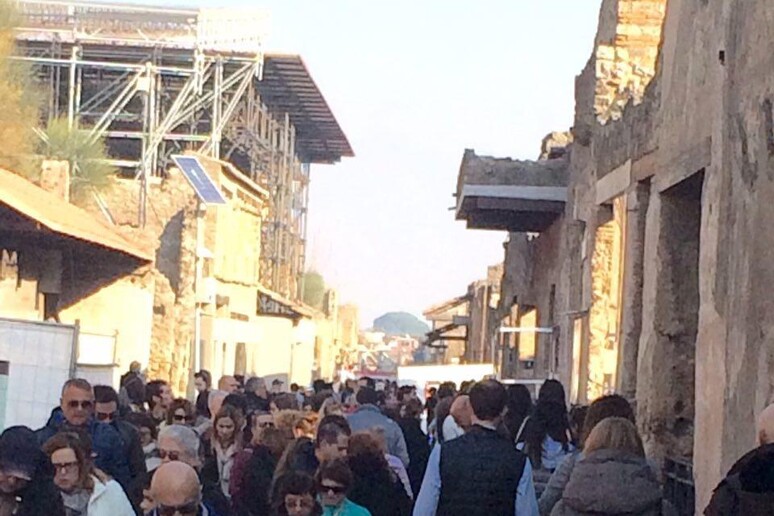Over 7,000 people visited six
newly opened 'domus' (residences) in Pompeii on Sunday and over
5,000 in the morning alone of Monday.
Lines are everywhere at the archaeological site in this
holiday period, with crowds at the Via dell'Abbondanza, where
the six newly restored domus were inaugurated on Christmas Eve
by Prime Minister Matteo Renzi.
"There have been a great number of visitors but we haven't
had any problems. The tourism was incredibly civilized and
orderly," ANSA was told by superintendent Massimo Osanna.
There are crowds everywhere but especially in the Fullonica
di Stephanus, an ancient laundry and fabric-dying workshop.
Osanna said that the most popular domus instead seems to be
that of Paquius Proculus, with electoral writings on its walls
and colorful floors. It is here, due to the delicacy of the
restored mosaics, that visitors must follow a sort of guided
tour on mats and the entrance is tightly controlled to prevent
excessive crowding.
The superintendent also praised the success thus far of two
guided tours organized alongside the regional culture institute
SCABEC. The first ('Di Domus in Domus') focuses on the domus and
the second ('Memorie e Suggestioni') on the amphitheater and an
exhibition of casts set up in a large pyramid designed by
Francesco Venezia.
Restored with about 3 million euros from the Grande
Progetto Pompei, the six new residences, the superintendent
said, have been reopened together "because as a group they offer
an extraordinary view of what must have been life in the Roman
city in the years immediately before the eruption of Vesuvius in
79 AD buried them in its ash."
In this way, places showing the life of the wealthy and
privileged are seen, such as the owner of the Domus dell'Efebo
must have been, who immediately after the earthquake that hit
the city in 63 AD bought and restored several homes next to each
other, making it into a sort of urban villa for his family.
There are also simpler homes of average people, such as
those of Fabius Amandio or Sacerdos Amandus, both small with
fewer rooms than the others but decorated with some refinement.
There is also the Criptoportico domus, which - Osanna said
- "must have been very prestigious in the age of Augustus, with
rooms decorated with very high quality paintings of scenes from
the Iliad and thermal baths", but after the earthquake of 63 AD,
it was likely sold and renovated, with what remained of the
cryptoporticus closed and turned into cellar.
The visit to the Fullonica is especially interesting. It
came to light in excavations between 1912 and 1914 led by
Vittorio Spinazzola, one of the most important laundries and
fabric-dying workshops discovered in Pompeii. It had large
basins for rinsing fed by constant water flow and stone ones for
dying, washing and getting rid of stains through the use of
specific types of mud or with urine. On the upper level there
were large terraces where the textiles were dried and a
'torcular' was used to iron them. Bearing witness to the
prestige of its owner are the tasteful wall paintings.
Stephanus, Osanna said, was undoubtedly an important man,
since "in a pre-industrial society like Pompeii, a dying
workshop was important and the 'fullones' like himself could
influence political elections."
The visit is 'a must', as is one to the home of Proculo the
baker, a rich and influential man (his portrait alongside his
wife is one of the icons of the Campania site and is exhibited
in Naples at the National Archaeological Museum) whose home has
a spectacular mosaic flooring and a sitting room and a peristyle
with Nile-like paintings on their walls in a nod to the
'Egyptomania' in vogue in those years in the Roman world.
ALL RIGHTS RESERVED © Copyright ANSA











